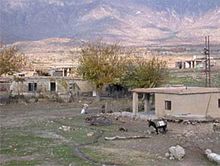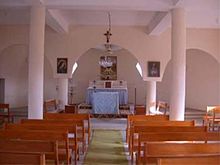- Dawodiya
-
Dawodiya is an Assyrian village close to the Sapna valley in the Iraqi province of Dohuk. Gara Mount bounds the Sapna valley to south and Matean Mount to the north. The valley stretches 25 kilometres in length and varies from 5 to 10 kilometres wide.
Some references indicate that the village of Dawodiyaof existed in pre-Christian times while others suggest that it was built in the Middle Ages. While residents of Dawodiya, are not certain of the village's exact age, they assume it was several centuries ago when some Assyrian Christian families escaped the persecution of Ottoman authorities during their original occupation of Botan in southern Turkey.
The British scholar Austen Henry Layard visited the village in the 1840s, spending one night there. In his writings he mentions that there were 200 families living in the village, a police station and a church. Layard also notes that Catholicism replaced the original denomination of those people who were the followers of the Assyrian Church of the East.[1]
There are remains of the former police station established by the Ottoman authorities. Residents believe it was a fortified structure for the commanding officer of the Ottoman army in the region.
Contents
St. John, the Baptist Catholic Church in Dawodiya
Before its destruction along with the rest of the village’s houses and farms by Saddam Hussein’s regime in 1988 Anfal campaign, this Church was one of the oldest churches in the area. The churches in this area were unique in their design and antiquity.
A typical church was typically large and separated by a thick wall (not less than one meter) from another smaller structure named after another saint.
The entrance to the main church passed through the smaller part, which always would be located to the south of the church. The altar was located in the east end and was placed slightly higher and separated by a thick wall. An arched door was in the middle of altar walls. To the southern part of the altar room was the baptism room.
The walls and ceiling of the church were built from stone and white mortar. The stones of which Saint John the Baptist was built were brought from nearby Mount Matean. The ceiling was arched but the roof surface was elevated because the outside walls were built to the same level as topmost of the arched ceiling so that walls and roof meet at same level outside.
The roof was destroyed in 1961 when the residents of Dawodiya were forced to flee from their homes during the civil war. But in early 1970s the bishop of the diocese of Amadiya decided to rebuild the ceiling. Thus new roofing of reinforced cement was placed and new and larger windows were built as well as a dome, bell, fences and reception hall were added to the church.
In 1988, the church and its old building and additions, could not withstand the destructive powers of dynamite, bulldozers and military might of the Saddam Hussein's regime. The church was flatted.
Among the residents of the village who were ordained to priesthood are: Lazar from the Safar family, Hanna from the Somo family and Fillip from the Isaac family. The village has another student preparing in Baghdad to be ordained to priest. The village also produced many deacons who excelled in the Syriac language. Late Metropolitan Hanna Markho served in the village before his death. Currently Ayyad, a visitor priest clergy from Mangesh, serves in the village.
Economy
Before the village's destruction, the plain lands of the village and plentiful water supplied from the Sapna River aids in the raising of crops through irrigation. Most common crops were apple, grape, tobacco, seasonal vegetables and grains. The grassy plains were available to raise domesticated animals such as sheep and cattle.
Destruction of the village
First destruction
With the arrival in 1961 of systematic aggression, deportation and attacks started against most of the Assyrian Christians and their villages in the district of Duhok. The aggression was committed by the warring parties, especially the Peshmerga associated with the central government against the Kurdish fighters. As a result many Assyrian villages were destroyed and their people forced to flee. In 1962 Dawodiya was attacked by the Peshmerga and its 82 houses were destroyed. Approximately one thousand families were forced to flee and take refuge in other towns and cities. Several families of kinship used to live in a single house, as it was then the customs of the eastern societies that married brothers would stay along with their families living together. The 1961 war set the first step toward immigration to other parts of Iraq and abroad.
After the situation became relatively normal and stable, many families returned to Dawodiya and rebuilt their houses and the village school using their own resources. Water supplies were restored and the church was rebuilt and renovated.
Second destruction
When Iran-Iraq war came to an end, the regime of Saddam Hussein began his (Alanfal) campaign to destroy all aspects of life in Northern Iraq.
In September 1988 was totally demolished including its entire 33 houses, the church and the priest residence, school and police station. Its residents were deported to other Iraqi cities and towns and were prevented from returning.
Dawodiya today
In the aftermath of the 1991 First gulf war war the Northern Iraq was declared by the collation forces a safe haven and was placed under their protection. The Assyrian people returned to their destroyded communities and began overhauling them. But the long and hard process of reconstruction was difficult due to economic hardship and a lack of resources caused by endless years of wars and the economic embargo imposed on Iraq. International humanitarian organizations ultimately opened the door of mercy for help and reconstruction.
Dawodiya became a major shelter for the returnees of the great exodus across the Turkish borders because of its convenient location near the highway. Once these refugees returned to their prospective homes and villages, residents of Dawodiya began reconstructing their homes and village. Seventeen primitive houses were built initially by Kurdistan Reconstruction Organization (KRO). Drinking water was restored and a generator was installed for generating electricity. Construction of the church was to be funded by the Danish Church Aid Organization through the Council of the Middle Eastern Churches but work has not yet been completed due to lack of funds.
See also
List of Assyrian villages
References
- ^ Cited in Nora Kubie, The Road to Nineveh: The Adventures and Excavations of Austen Henry Layard, Doubleday: 1964.
Categories:- Populated places in Dohuk Governorate
- Assyrian settlements
Wikimedia Foundation. 2010.


